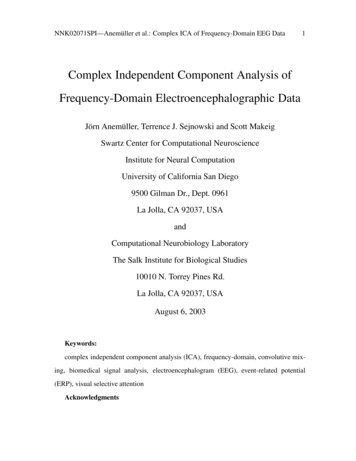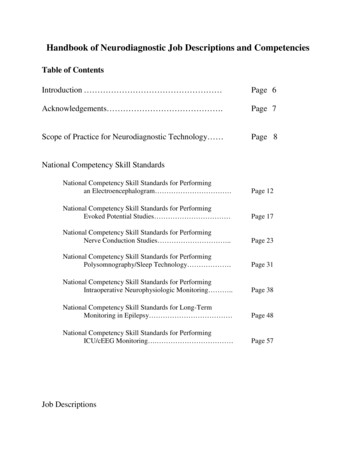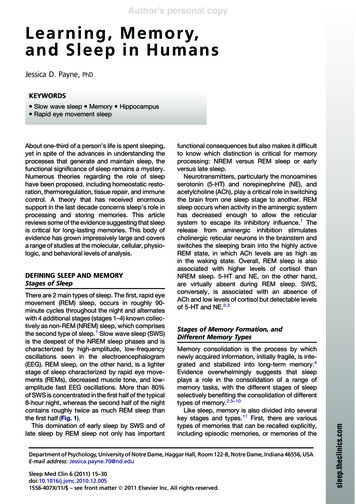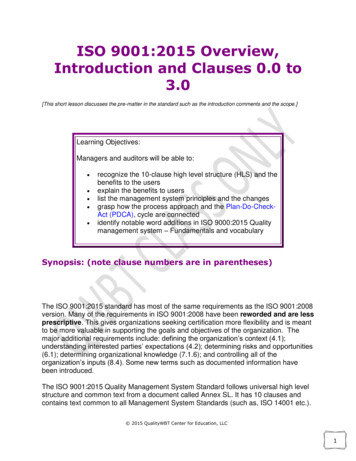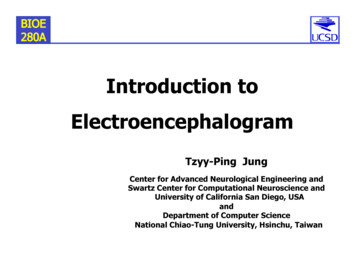
Transcription
Introduction toElectroencephalogramTzyy-Ping JungCenter for Advanced Neurological Engineering andSwartz Center for Computational Neuroscience andUniversity of California San Diego, USAandDepartment of Computer ScienceNational Chiao-Tung University, Hsinchu, Taiwan
Outline History of EEGWhy measure EEGBasic Physics of EEGEEG data collectionChallenges in EEG analysisAnalysis of EEG§ § Response averagingTime-frequency analysis
History of EEG In 1875, Richard Caton observed the EEG from the exposedbrains of rabbits and monkeys. In 1912, Russian physiologist, Vladimir VladimirovichPravdich-Neminsky published the first animal EEG and theevoked potential of the mammalian (dog). In 1914, Napoleon Cybulski and Jelenska-Macieszynaphotographed EEG-recordings of experimentally inducedseizures. In 1924, Hans Berger used his ordinary radio equipment toamplify the brain's electrical activity measured on the scalp. In 1934, Adrian and Matthews verified concept of “humanbrain waves” and identified regular oscillations around 10to 12 Hz which they termed “alpha rhythm”.
Why Measure the EEG ?The greatest advantage of EEG is its temporal resolution. EEG candetermine the relative strengths and positions of electrical activity indifferent brain regions.According to R. Bickford (1987) research and clinical applications ofthe EEG in humans and animals are used to:(1) monitor alertness, coma and brain death;(2) locate areas of damage following head injury, stroke, tumor, etc.;(3) test afferent pathways (by evoked potentials);(4) monitor cognitive engagement (alpha rhythm);(5) produce biofeedback situations, alpha, etc.;(6) control anesthesia depth (“servo anesthesia”);(7) investigate epilepsy and locate seizure origin;(8) test epilepsy drug effects;(9) assist in experimental cortical excision of epileptic focus;(10) monitor human and animal brain development;(11) test drugs for convulsive effects;(12) investigate sleep disorder and physiology.R.D. Bickford. Electroencephalography. In: Adelman G. ed. Encyclopedia of Neuroscience,371-3, 1987.M. Teplan, Fundamental of EEG Measurement, In: Measurement Science Review, 2, 2002.
Current Neuroimaging ModalitiesEEGfMRIPETMEG In all modalities but EEG, the sensors are heavy. EEG is the only modality that does not require the head/body to be fixed. EEG might enable the monitoring of the brain functions ofunconstrained participants performing normal tasks in theworkplace and home.
When neurons are activated, local currents are produced. EEG measures the current that flow during the excitations of thedendrites of many pyramidal neurons in the cerebral cortex. Potential differences are caused by summed postsynapticpotentials from pyramidal cells that create diploes between somaand apical dendrites. Necessary conditions: Aligned neurons and synchronous activity.Figure is from Gazzaniga et al., Cognitive Neuroscience: Thebiology of the mind Norton and Company, 2009.
Single ScalpElectrodeNEURAL SYNCHRONIESSingleNeuron
EEG Acquisition Electrode caps, conductive jelly, ruler,injection and aid for disinfection. EEG amplifier unit, PC/laptop
EEG ElectrodesIn common applications, EEG signals are measure by an electrode withelectrolyte gel placed directly on the skin.The coupling between skin and electrode can be described as a layeredconductive and capacitive structure, with series combinations of parallel RCelements.Equivalent circuitFrom Chi, Jung & Cauwenberghs, 2010.
EEG ElectrodesComparison of electrical coupling of the skin-electrode interface between electrodesTypically, one of the RC sections dominates and the electrical coupling may besimply represented as a single element with conductance gc in parallel withcapacitance Cc , Yc(jω) gc jωCc.From Chi, Jung & Cauwenberghs, 2010.
EEG ElectrodesThe conventional notion that low resistance (high conductance) is essential forgood electrode performance could be misleading in certain cases.Source input-referred noisepower density:Vs, rms can be reduced to zero in two limits: either infinite couplingconductance (low-resistance contact sensing), or infinite couplingimpedance (capacitive noncontact sensing). This presents a ratherinteresting dichotomy—either of the two extreme cases of zero resistanceand infinite resistance of skin-electrode contact are actually optimalfor low-noise signal receptionFrom Chi, Jung & Cauwenberghs, 2010.
Practical Design Considerations To abrade the skin to obtain a low contact resistance (5–10kΩ ). To employ an amplifier with very high input impedance such thatthe skin-electrode impedance becomes negligible.From Chi, Jung & Cauwenberghs, 2010.
Comparison for EEG ElectrodesStandard wet electrodes : low skin impedance, and buffer the electrodeagainst mechanical motion. But, they may be messy, time-consuming,irritating during preparation and cleaning, and the signal quality degradesover time.Rigid metal electrodes: subject to motion artifactsDry foam electrode (Gruetzmann et al., 2007): comfortable and stable withincreased resistance to motion artifact, but difficult to assess hair-bearingsites.MEMS sensors: low skin impedance. But, they may be irritating and difficultto penetrate the hairs.Microprobe electrodes: sensitive to motion artifacts.Non-contact sensors: sensitive to motion artifacts, poor settling times.Friction between the electrode and insulation can cause large voltageexcursion at the sensitive input.Epidermal electrodes (Kim eta al., 2011): very comfortable and stable withincreased resistance to motion artifact, but difficult to assess hair-bearingsites.
Wearable EEG Devices
EEG MontageInternational 10-20 system
Electrode Position/orientation Measuring
What EEG/ERPs Can and CannotTell Us About Brain FunctionsCAN Precise timing of neural activity Sequence of mental operationsCANNOT Precise brain location of neural activity
Challenges of EEG Analysis Pervasive artifacts EEG recordings aremixtures of all brainactivities arisingfrom differentnetworks Response variability Inverse problem others21
Human ElectrophysiologyEvent-related Potentials(ERPs)Time-domain average of EEGsignals both time- andphase-locked to stimuluspresentation or subjectresponse.On-going (spontaneous)EEGTime-frequency dynamics Event-relatedsynchronization or desynchronization Event-related spectralperturbation (ERSP)26
What is ERP?ERPs (Dawson, 1937) are changes in theelectrical activity of the brain which occurtime-synchronized In response to physical stimuli In association with mental activity In preparation of actions(Picton, 1980)
ERP ModelEEGdata ERP NOISEEEG1EEG4EEG2
Effects of Transforming Raw Data
Theorem of Signal Averaging“Backgroud” EEG
Naming of ERP Components
ERP Image
Averaged ERP across Trials
Averaged ERP across Trials
Averaged ERP across Subjects
EEG Analysis Time- & Phase-locked Potentials– Evoked Potentials (EPs, exogenous / sensory )– Event-Related Potentials (ERPs, endogenous/cognitive) Contingent Negative Variation (CNV), ‘Here itcomes !’, Walter et al., 1964) P300 (‘Oh, there’s one!’) N400 (‘Huh?’) ERN (‘Oops!’) On-going (spontaneous) EEG– Frequency-domain analysis– Time-frequency analysis (Event-related spectralperturbation)– Event-related (de-) synchronization(Pfurtscheller et al., 1979)
Frequency-domain Analysis of the EEG Joseph Fourier (1768-1830) Any complex time series can be broken downinto a series of superimposed sinusoids withdifferent frequencies.Summation of the signals
Fourier AnalysisFourier-Transformation: H ( f ) h(t )e 2πift dt ; h(t ) 2πiftH(f)e Diskrete Fourier-Transformation (O(N²)):1X (k ) NN 1N 1 x[n]e ik (2π / N )nk 0,1,., N 1n 0x[n] X (k )eik ( 2π / N ) nn 0,1,., N 1k 0Fast Fourier Transform (FFT), Cooley und Tukey (1965)
Fourier AnalysisFREQUENCY (Hz)!
Fourier Transform Advantage:For many signals, Fourier analysis is extremelyuseful because the signal's frequency content isof great importance. Disadvantage:Fourier analysis has a serious drawback.In transforming to the frequency domain, timeinformation is lost.
Frequency-domain Analysis of the EEGEEGDistributionSubjective feelingAssociatedtasks ution:generally broad ordiffuseddeep, dreamless sleep,non-REM sleep,unconsciouslethargic, notmoving, notattentivenot moving,low-level ofarousalThetausually regional,may involve manylobesintuitive, creative,recall, fantasy, imagery,creative, cusedhealing,integration ofmind/body8-12regional, usuallyinvolves entireloberelaxed, not agitated,but not drowsymeditation, noactionrelaxed,healingBetalocalizedalertness, agitationmental activity,e.g. mathalert, activevery localizedFocused formationrich taskprocessingBands (Hz)4-8Alpha12-30Gamma 30
Time-Frequency Analysis of the EEG We often apply a ‘window’ to the data. This simply means taking the amount wewant from the data stream ieThe window is moved along the data; we performthe FFT on this windowed data
Phasor
Spectrogram0 ms 10 ms 20 ms 30 ms 40 ms 50 ms 60 ms5 HzAverage ofsquaredvalues10 Hz20 HzERSP( f , t ) 30 Hz5 Hz10 Hz20 Hz30 Hz0 ms 10 ms 20 ms 30 ms 40 ms 50 ms 60 ms1 n2Fk ( f , t ) n k 1
Absolute versus Relative PowerAbsolute power ERSRelative ERSP (dB or %)Makeig, Clinical Neurophysiology, 1993.
Time-Frequency Analysis of the EEGMakeig & Inlow (1993)Electroenceph Clin Neuro
Event-related (De-)Synchronization Time- but NOTphase-lock signals Highly frequencyspecific ERD/ERS arelocationdependentFigure is from Pfurtschellera & Lopes da Silvab, Clinical Neurophys., 1999.
Time-locked Spectral Changes Time- & phase-locked ERP40 Hz10 Hz(time-lockedbut notphase-lock)1 Hz(phaselocked)
ERSP vs ERP10 Hz1 HzERP?
Forward Solution and Inverse ProblemFigure is copied from Gazzaniga et al., Cognitive Neuroscience:The biology of the mind Norton and Company, 2009.
Source Localization with ERP Data
Magnetoencephalogram (MEG)David Cohen, 1968.Slide is modified from Houches and Hipp, 2007.
Source Localization EEG vs MEG
healing, integration of mind/body Alpha 8-12 regional, usually involves entire lobe relaxed, not agitated, but not drowsy meditation, no action relaxed, healing Beta 12-30 localized alertness, agitation mental activity, e.g. math alert, active Gamma 30 very localized Focused arousal high-level information processing, "binding"
